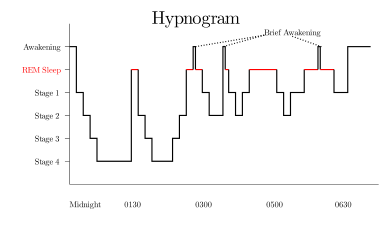Sleep architecture

Sleep architecture describes the structure and pattern of sleep and encompasses several variables. Sleep quotas refer to the amount of time spent in REM and NREM sleep. Sleep duration is the total time spent asleep in a 24-hour period. The duration of a NREM-REM cycle (from the beginning of NREM to the end of REM) is also an important aspect of sleep architecture. Phasing of sleep describes how sleep is distributed across a daily cycle: polyphasic sleep consists of multiple bouts of sleep in a 24-hour period, while monophasic sleep consists of a single bout of sleep in a 24-hour period. Sleep architecture varies widely across species, and is thought to be significantly influenced by genetics.[1] The evolution of different types of sleep architecture is influenced by a number of selective pressures, including body size, relative metabolic rate, predation, type and location of food sources, and immune function.[1][2][3][4]
See also
References
- ↑ 1.0 1.1 McNamara, P., R. A. Barton, and C. L. Nunn. 2010, Evolution of sleep: Phylogenetic and functional perspectives. Cambridge University Press, Cambridge.
- ↑ Capellini, I., C. L. Nunn, P. McNamara, B. T. Preston, and R. A. Barton. 2008. Energetic constraints, not predation, influence the evolution of sleep patterning in mammals. Functional Ecology 22:847-853.
- ↑ Acerbi, A., P. McNamara, and C. L. Nunn. 2008. To sleep or not to sleep: The ecology of sleep in artificial organisms. BMC Ecology 8:10.
- ↑ Preston, B. T., I. Capellini, P. McNamara, R. A. Barton, and C. L. Nunn. 2009. Parasite resistance and the adaptive significance of sleep. Bmc Evolutionary Biology 9.